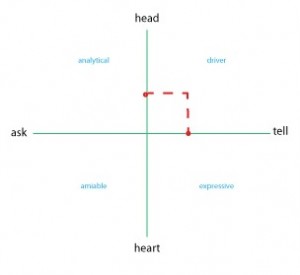People communicate in predictable patterns or styles. There are clues in what people say and do that can give you a clear idea of their dominant personality style. Each person has a communication pattern that is his or her “comfort zone” and it takes confidence and practice to expand this zone.
In order to have a good working relationship with clients, prospects, colleagues etc you need to discover the typical needs and expectations of their personality style. There are four basic patterns or styles – Driver, Amiable, Expressive and Analytical.
Although you will “see” yourself in more than one style, each of us possesses one of the four styles in a dominant manner dependent on the situation you are in. Often you will find your style differs at home and work. Your style is more authentic in your personal interactions. There is no good or bad style. Each style has its own strengths and weaknesses.
As in all areas of marketing you must enhance your strengths and work to eliminate the weaknesses. There is a simple exercise that you can do to determine your own personality style – but note this isn’t about you! It’s about understanding the people you are dealing with to get the best out of various situations.
Draw a matrix like the one I have illustrated this post with. On the vertical line put a dot on the place that you fit – do you make decisions with your HEAD or your HEART Do the same on the horizontal line asking yourself do you prefer to ASK or TELL? Take the dots out and up/down so you have a square in one of the quadrants when your lines meet. This is your dominant personality style for the circumstances you answered the questions.
DIFFERENT NEEDS OF EACH STYLE
In order to interact effectively with each style you need to adapt your own behaviour to accommodate that person’s needs.
DRIVER
- Be very businesslike.
- Let them make the decisions.
- Support their ideas – not them personally.
- No small talk.
- To influence decisions, provide alternative actions with brief supporting analysis.
- Be good, be brief and be gone!
ABOVE ALL BE EFFICIENT AND COMPETENT
AMIABLE
- Show a personal interest.
- Assure them that you can be trusted.
- Offer suggestions.
- Allow them time to trust you.
- Move along in an informal and slow manner.
- Show that you are “actively” listening.
- Provide personal assurances that any actions will involve minimum risk.
ABOVE ALL BE WARM AND SINCERE
EXPRESSIVE
- Give the person recognition.
- Support their opinion, ideas and dreams.
- Don’t argue.
- Control the conversation.
- Have specific objectives.
- Summarise in writing who is to do what, where, when etc.
- Be entertaining and fast moving.
- Use testimonials and incentives to positively affect decisions.
ABOVE ALL BE INTERESTED IN THEM
ANALYTICAL
- Be factual and specific.
- Pay attention to detail.
- Listen patiently.
- Have your facts in front of you.
- Give time to analyse.
- Praise thoroughness.
- Demonstrate through actions rather than words.
- List advantages and disadvantages of any plan.
- Provide solid, tangible, factual evidence.
- Provide guarantees that actions cannot backfire.
ABOVE ALL BE THOROUGH AND WELL PREPARED
More will follow on this topic in future posts but if you would like to find out more please email me.

